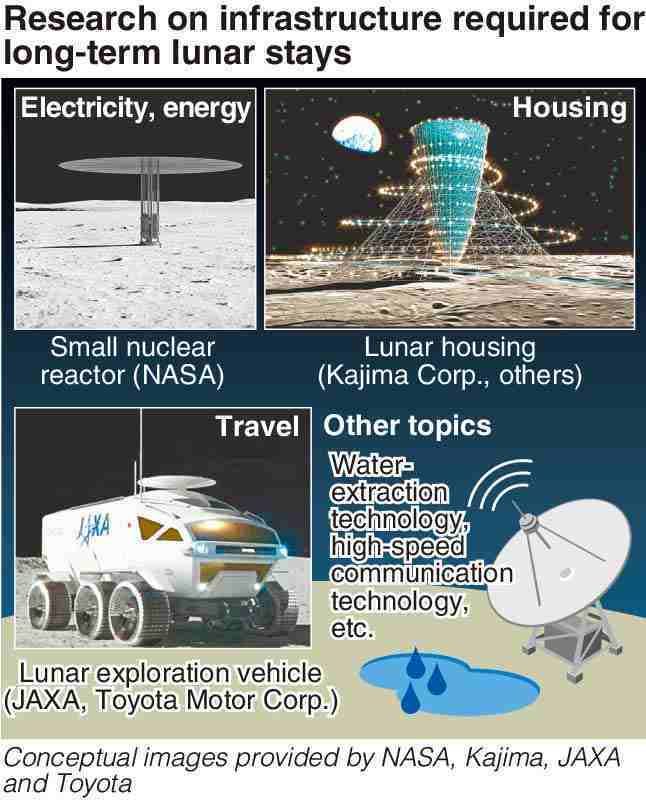Japan, U.S. rocketing ahead with lunar infrastructure plans

15:01 JST, August 13, 2022
The U.S.-led Artemis Program is shooting for the moon. The international lunar exploration program has a broad range of objectives, including the return of humans to the surface of Earth’s closest celestial neighbor for the first time since the Apollo 17 mission in 1972.
Research and development to install lunar infrastructure such as electricity, water and housing is currently in full swing in the United States and Japan, with the aim of building a habitable moon base that can facilitate long-term stays.
The Artemis Program, which comprises multiple missions, aims to construct a moon-orbiting base by the late 2020s, and later, another base on the lunar surface.
Astronauts will be tasked with exploring the moon’s surface, excavating its regolith and conducting various scientific experiments. Japan is one of eight partner countries participating in the mission and the government has set a goal of having a Japanese astronaut land on the moon by the late 2020s.
A stable supply of electricity is one of the major challenges facing long-term moon-based activities: It takes approximately 27 days for the moon to rotate once on its axis, so lunar days and lunar nights each last about two weeks. As such, electricity from solar power alone may not meet nighttime electricity demands.
The U.S. National Aeronautics and Space Administration (NASA) is currently eyeing nuclear power generation on the moon. In late June, NASA announced it had chosen three private companies to provide basic designs for a small nuclear reactor and would provide each firm with about $5 million (about ¥700 million).
If the project runs smoothly, a demonstration reactor will be built on the lunar surface, with construction starting as early as the late 2020s.
Water is essential for life, and it is believed that the lunar regolith contains this life-sustaining compound. NASA and Washington University in St. Louis will jointly build a rover-mounted drill and a laser-based monitoring device to quantify the amount and distribution of water beneath the moon’s surface.
In November 2024, an unmanned exploration vehicle will be sent to the celestial body to locate and extract water from the regolith.
The Japan Aerospace Exploration Agency (JAXA) and Japanese automaker Toyota Motor Corp. have been developing a pressurized rover called “Lunar Cruiser,” which astronauts can drive without wearing a spacesuit. Their aim is to send the two- or four-seater hydrogen fuel cell vehicle to the moon by 2029.
Kyoto University and the major contractor Kajima Corp., meanwhile, have proposed housing facilities for lunar-based human habitation.
The envisioned facilities comprise a large glass-shaped structure measuring 200 meters in diameter and 200 to 400 meters in height that can rotate to create a centrifugal force. This would allow about 1,000 people to live in an environment with a similar level of gravity to that of the Earth, according to the university and the company.
The moon’s gravity is about one-sixth of that of the Earth’s.
JAXA is currently working with private companies and other organizations to develop high-speed communication technology for use between our home planet and its single natural satellite, and a joint research project aims to create a lunar version of the Global Positioning System by launching multiple satellites above the moon.
The Education, Culture, Sports, Science and Technology Ministry plans to allocate a budget of ¥900 million to develop related technologies this fiscal year.
“We’re keen to accelerate development so Japanese technologies can serve as international standards in the future,” a ministry official said.



